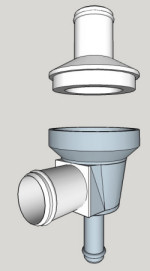Miata cooling system thread
#102
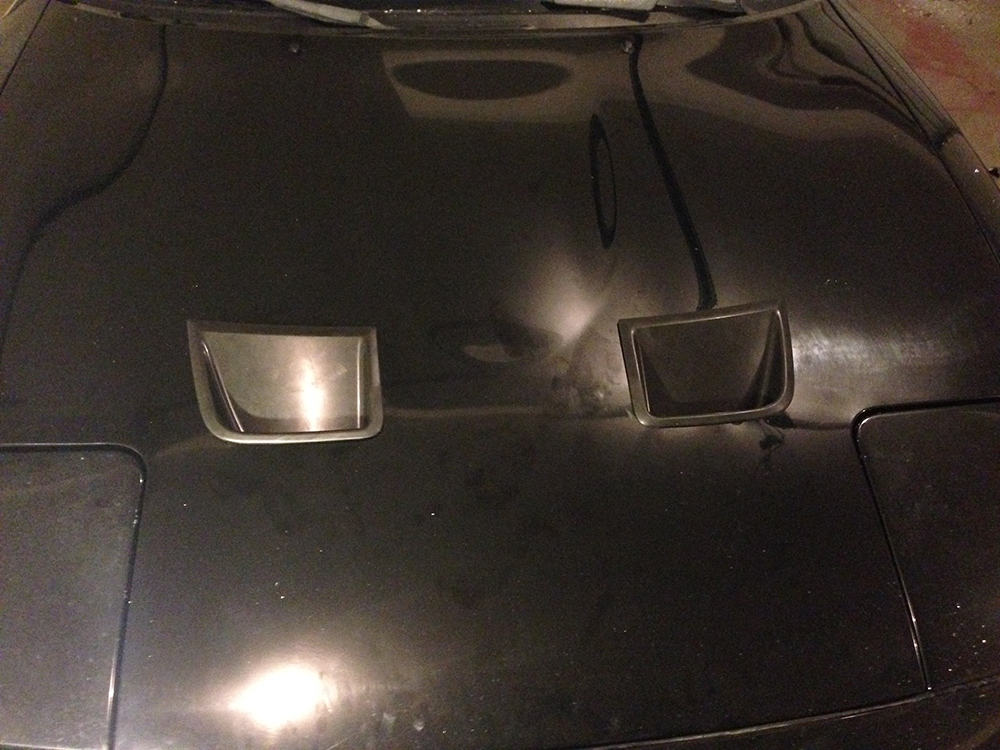
I recently completed an install of the WRX vents in my hood as well. The only information I have however is from street driving.
My variables:
BEGI S turbo kit w/ intercooler.
Trackspeed crossflow radiator
Reroute kit
180 degree thermostat.
Altitude around 6000 ft
Megasquirt
Fans come on at 210 degrees and shut off at 200
Three different stages of radiator ducting and recorded behavior:
Ducted front, no hood vents, no tray behind radiator:
OAT ranged from 94-98 over the days I tested
190 on the highway and 215 in town driving.
Ducted front, no hood vent, tray behind radiator:
OAT around 93-98
Maintains 185 highway, 210 in town. Can run AC on highway and it stays at 190, unless a simi trailers length behind another car, then would get to 200-210. Did not run AC in town.
Ducted front, hood vents, tray behind radiator:
OAT 88-98
Maintains 179 on highway, 200 in town, With AC running: 179-181 highway, 210 in town.
Last edited by Dlaitini; 08-07-2014 at 02:32 AM. Reason: putting text from above image to below as vent type was being asked about by several people
#104
I recently completed an install of the WRX vents in my hood as well. The only information I have however is from street driving.
My variables:
BEGI S turbo kit w/ intercooler.
Trackspeed crossflow radiator
Reroute kit
180 degree thermostat.
Altitude around 6000 ft
Megasquirt
Fans come on at 210 degrees and shut off at 200
Three different stages of radiator ducting and recorded behavior:
Ducted front, no hood vents, no tray behind radiator:
OAT ranged from 94-98 over the days I tested
190 on the highway and 215 in town driving.
Ducted front, no hood vent, tray behind radiator:
OAT around 93-98
Maintains 185 highway, 210 in town. Can run AC on highway and it stays at 190, unless a simi trailers length behind another car, then would get to 200-210. Did not run AC in town.
Ducted front, hood vents, tray behind radiator:
OAT 88-98
Maintains 179 on highway, 200 in town, With AC running: 179-181 highway, 210 in town.
My variables:
BEGI S turbo kit w/ intercooler.
Trackspeed crossflow radiator
Reroute kit
180 degree thermostat.
Altitude around 6000 ft
Megasquirt
Fans come on at 210 degrees and shut off at 200
Three different stages of radiator ducting and recorded behavior:
Ducted front, no hood vents, no tray behind radiator:
OAT ranged from 94-98 over the days I tested
190 on the highway and 215 in town driving.
Ducted front, no hood vent, tray behind radiator:
OAT around 93-98
Maintains 185 highway, 210 in town. Can run AC on highway and it stays at 190, unless a simi trailers length behind another car, then would get to 200-210. Did not run AC in town.
Ducted front, hood vents, tray behind radiator:
OAT 88-98
Maintains 179 on highway, 200 in town, With AC running: 179-181 highway, 210 in town.
__________________
#108
and if it's sucked in it tells you something else 
I did another cooling project (controlling airflow) on mine inspired by and old photo of Crusher, walls between the frame rails and the hood to shield the dome filter and master cylinders from radiator air.
I saw 65C IAT when slowing down after a tuning run before and after only 5-10C above ambient (more if I let it sit for some time). When running only 2C over ambient.
And the plastic material did not deform during a track test either (only 10-15 min runs though), but no temp logs from that.
I have not measured the pressures or flows but with no splashguards at all I would not be surprised if the wheel well pressure is higher than the engine bay pressure (supported by the NB air intake hole?). In that case I now have a flow of cool air to the intake and flowing past the master cylinders.
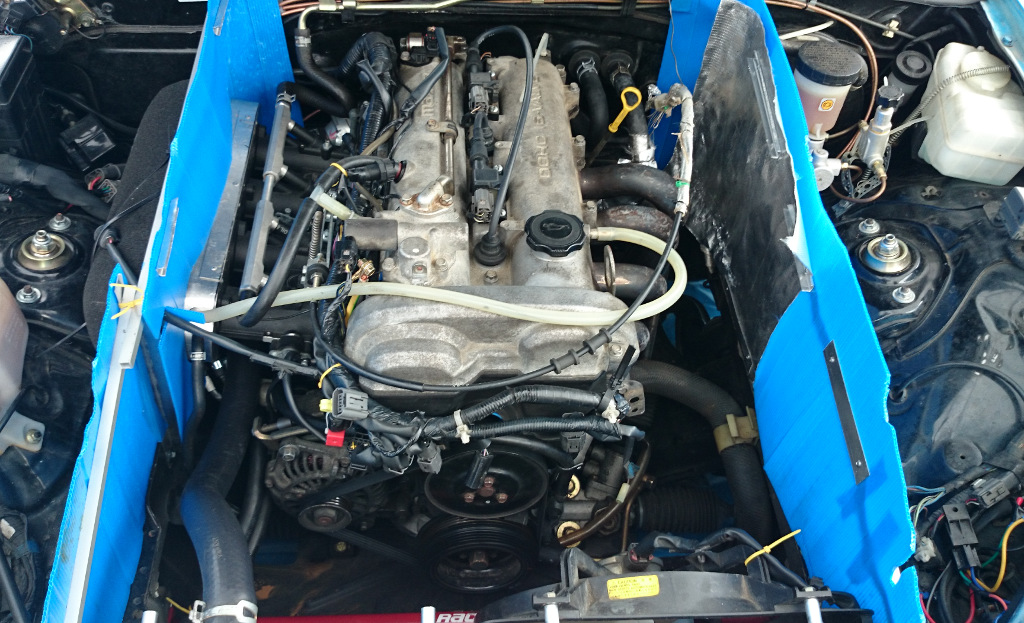
The plastic have held up for one test day and a race week och sprints. Nothing hotter than 80F ambient though.
It have melted/softened where the hood rubs, so it's now reasonably tight fit.

I did another cooling project (controlling airflow) on mine inspired by and old photo of Crusher, walls between the frame rails and the hood to shield the dome filter and master cylinders from radiator air.
I saw 65C IAT when slowing down after a tuning run before and after only 5-10C above ambient (more if I let it sit for some time). When running only 2C over ambient.
And the plastic material did not deform during a track test either (only 10-15 min runs though), but no temp logs from that.
I have not measured the pressures or flows but with no splashguards at all I would not be surprised if the wheel well pressure is higher than the engine bay pressure (supported by the NB air intake hole?). In that case I now have a flow of cool air to the intake and flowing past the master cylinders.

The plastic have held up for one test day and a race week och sprints. Nothing hotter than 80F ambient though.
It have melted/softened where the hood rubs, so it's now reasonably tight fit.
Last edited by NiklasFalk; 08-18-2014 at 07:46 PM. Reason: added picture
#109
Joined: Sep 2005
Posts: 33,556
Total Cats: 6,933
From: Chicago. (The less-murder part.)
Been lurking in this thread for a while. I really enjoy seeing this sort of discussion.
What you've designed there is similar to the the OEM thermostat from a '70s vintage BMW 2002. Stant P/N 13578.
BMW 2002 Thermostat - Free Shipping - Stant, Beck Arnley, Wahler
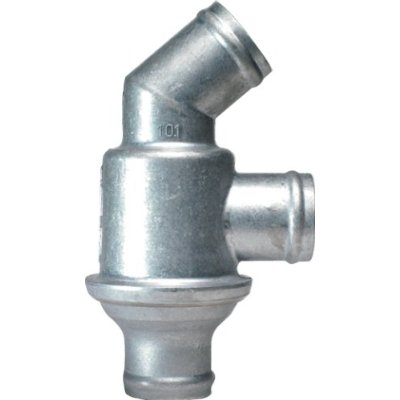
(I can't tell from the picture if yours seals off the mixing manifold port when the radiator port opens fully)
I've also seen a few similar aftermarket designs:
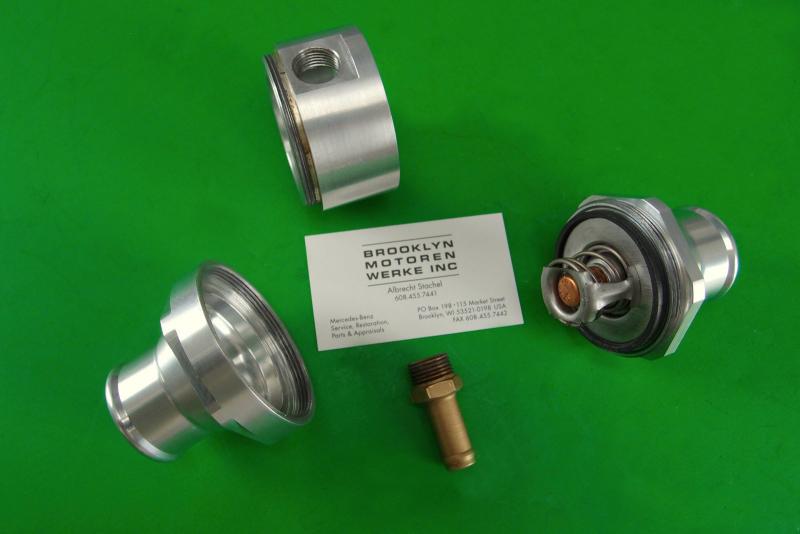
Billet Aluminum Bypass Thermostat for Mercedes-Benz Ponton (180a, 190, 219, 220, 220a, 220S) and Unimog 404 | Brooklyn Motoren Werke, Inc.
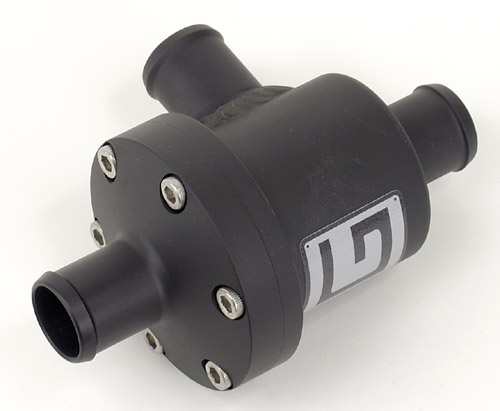
HyperRacing - Online Store - 59-847 - 2-Stroke Thermostat with Bypass
(Those who have been around MT a while, and have followed the various cooling system discussions over the years, will laugh when they notice the name of the above company.)
Bypass thermostats are indeed the best of all possible scenarios. No need for a mixing manifold. If you really wanna get fancy, do the same on the heater core outlet. Note that the aftermarket units above are not equal to the BMW part.
Haha. I really meant for that video to be a joke years ago. Keeps popping up.
My experience in doing that test was that, for the specific units which I tested, the "Superstat" unit took longer to open, and reached a smaller total opening, than the standard unit.
Emilio's data, that the Superstat should provide superior flow, contradicts my observation. As I made only visual observations and did not perform an actual flow test, I cannot say with 100% certainty which is correct. It is possible that Stant merely has really bad QC, and that the units which I tested differ greatly from Emilio's.
Also, I note that nobody has yet posted actual pictures of the difference between a '94-'00 head gasket and an '01-'05 gasket, to illustrate what Mazda was trying to accomplish, and where the concern about doing a reroute on the VVT engines originated from.
Here are the head gaskets from a '99 and an '03 engine. I have highlighted in blue the active coolant passages in each:
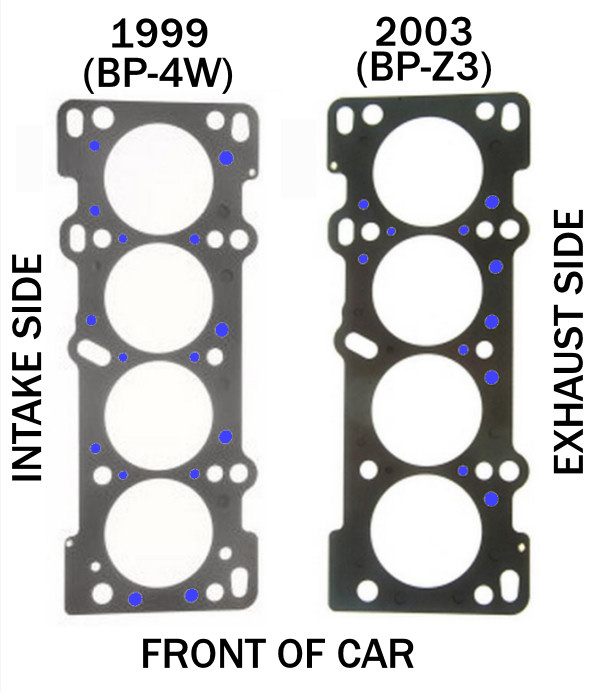
In the early design, you can see that the coolant passages are fairly evenly distributed across the gasket. In the '01-'05 design, this has changed radically. The holes are now clustered around the #2 and #3 cylinders, and heavily biased towards the exhaust side. This is a very good compromise design, if we presuppose the necessity of a front-thermostat, rear-heater layout. When the thermostat is open, coolant will flow up through the middle of the engine, and then move both forwards (towards the thermostat) and rearwards (towards the heater core outlet) to exit the engine. Thus, the flow of coolant across the front and rear of the head is fairly even.
I was one of the first to raise a concern about this about 4-5 years ago when we first started seriously discussing the reroute concept in the VVT engine. Specifically, my concern was (and continues to be) that with the front thermostat port blocked off completely, you can clearly see how the area around the #1 cylinder will receive virtually no coolant flow at all, with extremely little flow around the intake side of #2 as well.
This concern was based, as Curly notes, purely on conjecture. To this day, I have yet to test a reroute on an '01-'05 engine with the stock head gasket. To the best of my knowledge, nobody else has actually instrumented the head itself (eg: by drilling into it and installing thermocouples in different locations across it) in a way that conclusively proves or disproves the notion that a rear-thermostat reroute will actually increase the temperature differential across the head, even though average operating temperature may go down.
In my opinion, the most optimal cooling system configuration for an '01-'05 engine, presupposing that the stock head gasket is still in place, is to leave the front thermostat alone and add a bypass-style thermostat to the heater core outlet which selects between the upper radiator hose and the mixing manifold depending on temperature. While this is purely speculation, I see no reason why this configuration should not provide both the most even temperature distribution across the head, and also the greatest capacity for overall heat removal.
BMW 2002 Thermostat - Free Shipping - Stant, Beck Arnley, Wahler

(I can't tell from the picture if yours seals off the mixing manifold port when the radiator port opens fully)
I've also seen a few similar aftermarket designs:

Billet Aluminum Bypass Thermostat for Mercedes-Benz Ponton (180a, 190, 219, 220, 220a, 220S) and Unimog 404 | Brooklyn Motoren Werke, Inc.

HyperRacing - Online Store - 59-847 - 2-Stroke Thermostat with Bypass
(Those who have been around MT a while, and have followed the various cooling system discussions over the years, will laugh when they notice the name of the above company.)
Bypass thermostats are indeed the best of all possible scenarios. No need for a mixing manifold. If you really wanna get fancy, do the same on the heater core outlet. Note that the aftermarket units above are not equal to the BMW part.
Haha. I really meant for that video to be a joke years ago. Keeps popping up.
My experience in doing that test was that, for the specific units which I tested, the "Superstat" unit took longer to open, and reached a smaller total opening, than the standard unit.
Emilio's data, that the Superstat should provide superior flow, contradicts my observation. As I made only visual observations and did not perform an actual flow test, I cannot say with 100% certainty which is correct. It is possible that Stant merely has really bad QC, and that the units which I tested differ greatly from Emilio's.
Also, I note that nobody has yet posted actual pictures of the difference between a '94-'00 head gasket and an '01-'05 gasket, to illustrate what Mazda was trying to accomplish, and where the concern about doing a reroute on the VVT engines originated from.
Here are the head gaskets from a '99 and an '03 engine. I have highlighted in blue the active coolant passages in each:

In the early design, you can see that the coolant passages are fairly evenly distributed across the gasket. In the '01-'05 design, this has changed radically. The holes are now clustered around the #2 and #3 cylinders, and heavily biased towards the exhaust side. This is a very good compromise design, if we presuppose the necessity of a front-thermostat, rear-heater layout. When the thermostat is open, coolant will flow up through the middle of the engine, and then move both forwards (towards the thermostat) and rearwards (towards the heater core outlet) to exit the engine. Thus, the flow of coolant across the front and rear of the head is fairly even.
I was one of the first to raise a concern about this about 4-5 years ago when we first started seriously discussing the reroute concept in the VVT engine. Specifically, my concern was (and continues to be) that with the front thermostat port blocked off completely, you can clearly see how the area around the #1 cylinder will receive virtually no coolant flow at all, with extremely little flow around the intake side of #2 as well.
This concern was based, as Curly notes, purely on conjecture. To this day, I have yet to test a reroute on an '01-'05 engine with the stock head gasket. To the best of my knowledge, nobody else has actually instrumented the head itself (eg: by drilling into it and installing thermocouples in different locations across it) in a way that conclusively proves or disproves the notion that a rear-thermostat reroute will actually increase the temperature differential across the head, even though average operating temperature may go down.
In my opinion, the most optimal cooling system configuration for an '01-'05 engine, presupposing that the stock head gasket is still in place, is to leave the front thermostat alone and add a bypass-style thermostat to the heater core outlet which selects between the upper radiator hose and the mixing manifold depending on temperature. While this is purely speculation, I see no reason why this configuration should not provide both the most even temperature distribution across the head, and also the greatest capacity for overall heat removal.
#112
What you've designed there is similar to the the OEM thermostat from a '70s vintage BMW 2002. Stant P/N 13578.
BMW 2002 Thermostat - Free Shipping - Stant, Beck Arnley, Wahler

BMW 2002 Thermostat - Free Shipping - Stant, Beck Arnley, Wahler

__________________
#113
Electric water pumps: We have preliminary results. We installed one with a very cool controller on our supercharged NC. The thermostat is removed as is the stock water pump impeller. The water pump cycles depending on water temp - when the car's cold, it pulses for a few seconds at a time to keep coolant moving. Then it starts to increase duty cycle and speed with temperature.
No instrumented testing, just a torture test. At our Summer Camp, we run the FM cars twice as often as the customer cars. It's a short, tight track with a lot of acceleration and limited airflow. Our air is thin and dry, so it's pretty much a worst-case scenario for cooling cars. The FM cars run for about 10 minutes, then get a 25 minute rest. The heatsoaking starts to really punish the cars as the day goes on. Ambient temps were roughly 95F.
We know from previous years that the supercharged NC will start to overheat fairly soon with this treatment. With no other changes other than the electric pump, it didn't even budge the gauge. So far, very good.
We're going to install one on our turbo NB next.
No instrumented testing, just a torture test. At our Summer Camp, we run the FM cars twice as often as the customer cars. It's a short, tight track with a lot of acceleration and limited airflow. Our air is thin and dry, so it's pretty much a worst-case scenario for cooling cars. The FM cars run for about 10 minutes, then get a 25 minute rest. The heatsoaking starts to really punish the cars as the day goes on. Ambient temps were roughly 95F.
We know from previous years that the supercharged NC will start to overheat fairly soon with this treatment. With no other changes other than the electric pump, it didn't even budge the gauge. So far, very good.
We're going to install one on our turbo NB next.
#116
Davies Craig added a metal version of the WP about a year ago IIRC. I think that is in response to requests from the motorsports community. When we saw the original plastic housing version at the PRI several years ago, that was the first question I asked. You could sorta tell he got asked that a lot at that show since the guy bristled a bit and regurgitated a kind of canned answer. In any case, I have heard and read first hand reports of the plastic version holding up just fine in motorsports applications. We bought one years ago but never installed or played with it. Eagerly awaiting more data from Keith.
__________________
#118
Joined: Sep 2005
Posts: 33,556
Total Cats: 6,933
From: Chicago. (The less-murder part.)
I believe that it does, but I've never actually held one in my hands. Emilio's comment just above this post makes me wonder- if this BMW part was the basis for the M-tuned reroute which came out a few years ago, I'd have expected that design to also incorporate a warm-bypass-blockoff, and it most certainly does not. (If it did, then the heater wouldn't work.)
To elaborate, for those not familiar with bypass thermostats. The idea here is to give the water exiting the engine an either-or choice of where to go. When cold, it's sent to the mixing manifold and prevented from entering the radiator. When hot, it's sent to the radiator and prevented from entering the mixing manifold.
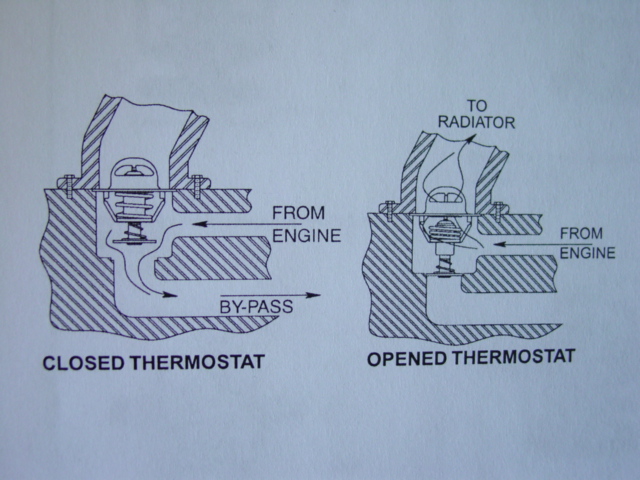
To accomplish this requires two plates with opposing action:
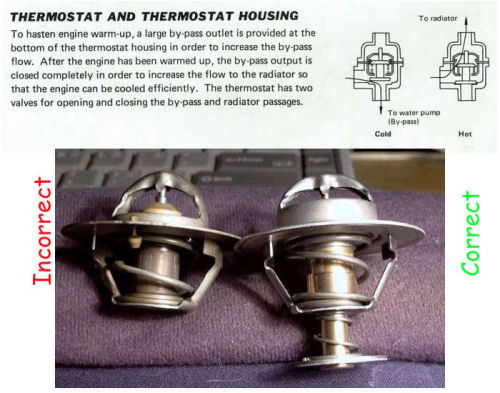
It is worth noting that the picture I posted earlier of the Brooklyn Motoren Werke part (green background) is NOT of this design. That unit lets hot water enter the mixing manifold at all times regardless of whether the thermostat is open or not, so in that regard it's functionally similar to the OEM Mazda design, the packaged reroutes sold by 949, Bell and FM, and the vast majority of the DIY reroutes out there. They all allow heater-core water to always re-enter the engine at the mixing manifold, regardless of thermostat position. Essentially, it's this:
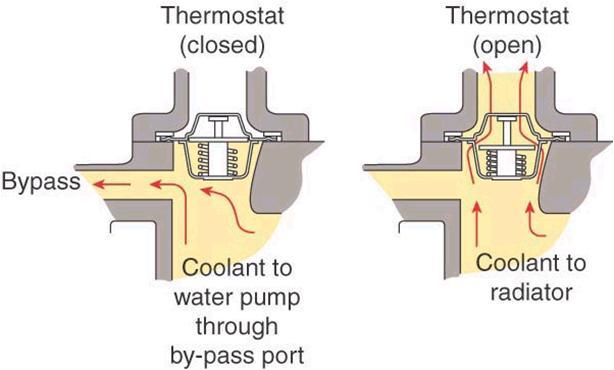
The Bell "Racer" reroute attempts, rather inelegantly, to solve this problem by directing the heater core return to the upper radiator hose all the time. That does solve the problem of hot water being re-introduced to the engine via the mixing manifold, however it creates a new problem- extremely long warmup times. Essentially bypassing the thermostat entirely, this presents a nearly catastrophic scenario for street-driven vehicles frequently operated in climates which are less hot than Death Valley in August.
In order for us to achieve the most optimum possible configuration (maximum cooling capacity, plus quickest warmup) for a vehicle subjected to extreme use, we must deal with the heater core outlet, diverting it to the upper radiator hose when the coolant is hot, and allowing it to enter the mixing manifold only when the coolant is cool.
I hypothesize that one could achieve excellent results on an '01-'05 engine (possibly better than what is achieved by doing an M-Tuned style rear-therm reroute on a '94-'00 engine) by leaving the OEM design completely alone and simply adding a BMW-2002-style bypass thermostat to the heater core outlet, selecting between the upper radiator hose and the mixing manifold. I'm undecided as to whether the bypass thermostat should have the same rating as the main thermostat, or if it should have a slightly cooler rating.
So, to butcher yet again the image that we've been marking up for years:
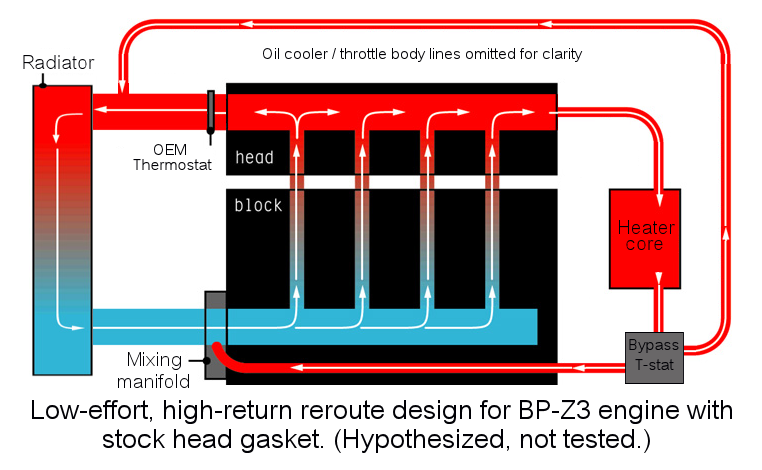
I first proposed this about 6 years ago, except with an oil thermostat, not realizing at the time why that wouldn't work, and not then being familiar with bypass-style water thermostats. It is my intention to do exactly this to my recently-acquired '04 whenever it comes time to add boost.
To elaborate, for those not familiar with bypass thermostats. The idea here is to give the water exiting the engine an either-or choice of where to go. When cold, it's sent to the mixing manifold and prevented from entering the radiator. When hot, it's sent to the radiator and prevented from entering the mixing manifold.

To accomplish this requires two plates with opposing action:

It is worth noting that the picture I posted earlier of the Brooklyn Motoren Werke part (green background) is NOT of this design. That unit lets hot water enter the mixing manifold at all times regardless of whether the thermostat is open or not, so in that regard it's functionally similar to the OEM Mazda design, the packaged reroutes sold by 949, Bell and FM, and the vast majority of the DIY reroutes out there. They all allow heater-core water to always re-enter the engine at the mixing manifold, regardless of thermostat position. Essentially, it's this:

The Bell "Racer" reroute attempts, rather inelegantly, to solve this problem by directing the heater core return to the upper radiator hose all the time. That does solve the problem of hot water being re-introduced to the engine via the mixing manifold, however it creates a new problem- extremely long warmup times. Essentially bypassing the thermostat entirely, this presents a nearly catastrophic scenario for street-driven vehicles frequently operated in climates which are less hot than Death Valley in August.
In order for us to achieve the most optimum possible configuration (maximum cooling capacity, plus quickest warmup) for a vehicle subjected to extreme use, we must deal with the heater core outlet, diverting it to the upper radiator hose when the coolant is hot, and allowing it to enter the mixing manifold only when the coolant is cool.
I hypothesize that one could achieve excellent results on an '01-'05 engine (possibly better than what is achieved by doing an M-Tuned style rear-therm reroute on a '94-'00 engine) by leaving the OEM design completely alone and simply adding a BMW-2002-style bypass thermostat to the heater core outlet, selecting between the upper radiator hose and the mixing manifold. I'm undecided as to whether the bypass thermostat should have the same rating as the main thermostat, or if it should have a slightly cooler rating.
So, to butcher yet again the image that we've been marking up for years:

I first proposed this about 6 years ago, except with an oil thermostat, not realizing at the time why that wouldn't work, and not then being familiar with bypass-style water thermostats. It is my intention to do exactly this to my recently-acquired '04 whenever it comes time to add boost.
#119
To this day, I have yet to test a reroute on an '01-'05 engine with the stock head gasket. To the best of my knowledge, nobody else has actually instrumented the head itself (eg: by drilling into it and installing thermocouples in different locations across it) in a way that conclusively proves or disproves the notion that a rear-thermostat reroute will actually increase the temperature differential across the head, even though average operating temperature may go down.

One more note on the differences between VVT heads and '99 heads. When Mazda changed the head gasket design, they added several cooling ports to the surface of the 01+ head (including the MSM). As a (likely unintended) result of this, nearly every coolant port on a 99-00 head ends up blocked off if you use a 99-00 head with an 01+ gasket. Out of 17 total ports, eleven of them end up blocked, with cylinders #1 and #2 sharing a single coolant port between them. Not good at all.
The ports in red are blocked:
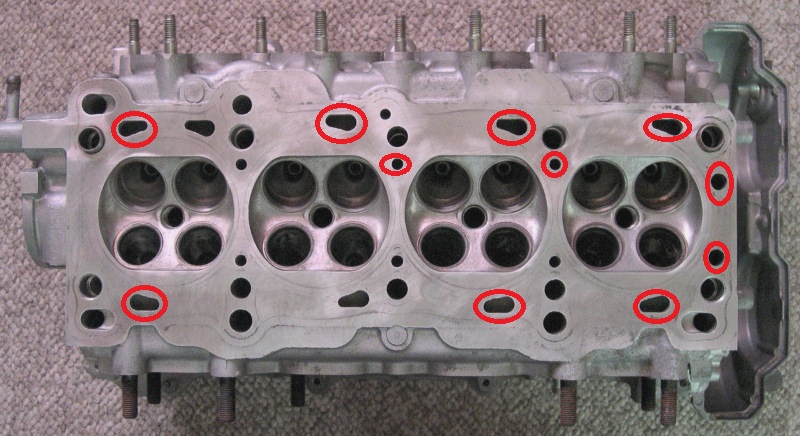
If you were thinking about using a BP6D gasket on your early engine to forego a reroute, don't.












